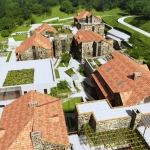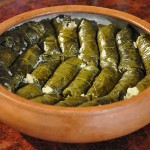
A presentation was held in March of 2010 on the new e-governance system being implemented in Armenia. The system is meant to help citizens become more involved in civic life, follow up with applications and complaints, monitor the government’s activities, and break down bureaucratic barriers.
In 2010, Armenia exported 1.5 times more electricity than it did in 2007. During the same
year, 56 small hydroelectric power plants were built in the country. Yerevan’s new thermal power plant was opened in April 2010. Recently, the fi fth block of Hrazdan’s thermal power plant also joined Armenia’s power grid.
1,570 km of roads were fully repaired in Armenia between 2008 and 2012. This is double the amount of roads repaired in the previous five years. Between 2008 and 2012, the Armenian government made major investments in the improvement of the country’s water supply system. These investments have gone towards the installation of 1932 km of pipes and the building of 86 drinking water pump stations, 100 irrigation pump stations, 179 reservoirs, and 423 km of irrigation pipes.
Between 2008 and 2012, the Armenian government made major investments in the improvement of the country’s water supply system. These investments have gone towards the installation of 1932 km of pipes and the building of 86 drinking water pump stations, 100 irrigation pump stations, 179 reservoirs, and 423 km of irrigation pipes.
The signifi cant decline in the yield of wheat crops in recent years meant that Armenia had to take serious measures in order to safeguard the country’s food security. For this reason, the government has imported and distributed more than 6.5 tons of wheat grain for planting. As a result, the yield in 2011 reached 37 hundredweights per hectare, a dramatic improvement from the former 20 hundredweights, and it continues to grow.
The Donate Life Foundation, a personal project of Armenian First Lady, Rita Sargsyan, was established in December of 2009. The founders of the Russian foundation of the same name, Chulpan Khamatova and Dina Korzun, came to Yerevan to support the cause and help raise funds for a blood donation center adjacent to the chemotherapy clinic. The Donate Life Foundation has already organized over ten charity events to help sick children.
As part of a project to modernize and develop Armenia’s medical facilities, the hospitals of Armavir, Ijevan, Hrazdan, Ararat, Aparan, Gavar, Gyumri and Goris have been fully equipped with modern instruments. A new system has also been created to improve the monitoring of and response to emergency situations.
The number of mobile phone users in Armenia has tripled over the past fi ve years, thanks to the promotion of competition in the fi eld of communications. During the same time period, the number of Internet users has increased 19-fold, and connection fees have dropped 120-fold.
In an eff ort to support the most vulnerable members of society during the financial crisis, state benefi ts and pensions were increased. The average pension was more than doubled.
Over the past five years, nearly 80 regional cultural centers have been renovated, and new cultural centers have been built in 10 communities. In addition, the theater houses of Gavar, Artashat, Vanadzor and Goris have been fully restored.
From 2008 to 2011, Armenian schools received around 17,000 computers. By the end of 2012, all schools will be connected to the Internet, where all information pertaining to Armenian educational institutions will be available. 93% of schools are already a part of this network.
In 2011, Yerevan Magazine and Yerevan.ru initiated a project, with the support of the municipality, to beautify archways and courtyards around Yerevan. Young artists and designers were invited to participate in the project, along with anyone who was interested in beautifying the city.
Between 2007 and 2011, the government spent $250 million on reconstruction efforts in disaster zones. Around 5,332 families, who were left without shelter after the 1988 earthquake, were given homes.
There has recently been a considerable increase in youth and civil movements in Armenia, drawing the attention of the government and private sector to issues such as ecology, urban planning, and the preservation of cultural heritage.
The export of Armenian fish to Russia and Georgia doubled in 2011. Armenia’s fish is certainly not the cheapest, but there is a great demand for it in foreign markets due to its distinctive flavor.
As a result of new policies related to nature protection, Armenia now has 76.3 more hectares of protected areas. The territory of Khosrov Reserve has been expanded and two new national parks have been added, Lake Arpi and Arevik.
Thanks to the Armenian government’s eff orts to restore and preserve the unique high-altitude ecosystem of Lake Sevan, the water level has been raised by 169 cm over the past four years.
In 2011, Armenal, the only company in the Caucasus and Central Asia that produces aluminum foil, exceeded the projected production capacity of its factory. The company is part of Rusal Group’s packaging division, along with Sayanal, Uralsky Aluminum, and Sayanski Aluminum.
Agarak’s copper-molybdenum plant was among the many companies affected by the international fi nancial crisis. In June 2009, the company began a string of layoff s. However, they received a loan from the Armenian government as part of crisis relief effort, and over the next three years, were able to overcome the economic downturn. Today, the
company is fully operational and is even looking to expand its employee base.
In September 2011, a state-of-the-art new flotation machine was installed at the Zangezur copper-molybdenum plant. Its production capacity is superior to all of the plant’s other machinery combined.
On September 30, 2010, President Serzh Sargsyan took part in the groundbreaking ceremony of the Golden Grape Armas Wine and Brandy Factory, in Aragatsotn province. The company was founded in 2007 on 200 hectares of uncultivated land. In the same year, they planted 400,000 grapevines and 10,000 fruit trees.
On November 7, 2011, the Armenian-Indian IT Center was opened at Yerevan State University, as part of a special agreement between the governments of Armenia and India. The center is equipped with the only supercomputer in the region, the PARAM. As Prime Minister Tigran Sargsyan said, the center will promote the development of the IT sector and the supercomputer will create new and exciting research opportunities.
The construction of the Central Bank of Armenia’s Dilijan Financial Training Center is moving forward with great speed. This center, featuring the latest technical and technological innovations, will host regional and international conferences, and lectures on economic and fi nancial issues. Construction will be completed in 2013.
The Armenian-Dutch company, Amster Flowers, is growing tomatoes, cucumbers and green peppers using cutting edge greenhouse technology in Armavir province. The company has invested €1.5 million in this project.
The international cargo transportation company, Spayka, is undertaking an investment project involving the export of fruits under the Ararat Fruit brand. This is another example of a well-timed state investment, and a result of the government creating favorable a favorable business environment. More than $45 million has already been invested in this project, which aims to secure a place for Armenian agricultural products in foreign markets, and to stimulate the Armenian export market.
In 2010, Synopsis Armenia was in the list of 12 finalists in the U.S. State Department’s annual contest for commendable corporate practice
The Luys Foundation was formed in 2008. This special program, initiated by President Serzh Sargsyan and Prime Minister Tigran Sargsyan, has given 175 students from Armenia and the Diaspora the chance to pursue studies in 12 different countries, at some of the world’s finest educational institutions, such as MIT, Cambridge, Oxford, Harvard, Yale, University of Toronto, and University of Geneva.
In 2011, the Armenian national football team was something of a sensation, as they came in third place in their division in the 2012 Euro Cup qualifi ers. Having come very close to making it through to the fi nals, they fi nished in 41st place in the FIFA ranking system, a record high for the club.










